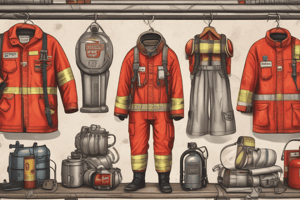Podcast
Questions and Answers
What should be the primary focus of a Company Officer when conducting a size-up for structural fire protection?
What should be the primary focus of a Company Officer when conducting a size-up for structural fire protection?
- The materials used in the structure's construction
- The types of plants surrounding the structure
- Ensuring firefighter safety and access for apparatus (correct)
- The availability of firefighting foam
When utilizing 'bump bags' for structure protection during interface fires, which component is NOT included?
When utilizing 'bump bags' for structure protection during interface fires, which component is NOT included?
- 1” forestry hose lines
- Gated 'y'
- Standard fire hydrant adapter (correct)
- 1 ½” 'trunk' line
In scenarios where water supply is limited, what is the recommended tactic for effective firefighting?
In scenarios where water supply is limited, what is the recommended tactic for effective firefighting?
- Wetting down the surrounding fuel beforehand
- Establishing a controlled burn of nearby vegetation
- Attempting to create a water reservoir
- Using water directly on burning materials (correct)
During structural protection efforts, what hazard is NOT typically a concern?
During structural protection efforts, what hazard is NOT typically a concern?
What is a key consideration for crews to maintain mobility during structure protection activities?
What is a key consideration for crews to maintain mobility during structure protection activities?
What is a critical initial step for the Company Officer when preparing for structure protection?
What is a critical initial step for the Company Officer when preparing for structure protection?
Which tactic should be employed when dealing with limited water sources during structure protection?
Which tactic should be employed when dealing with limited water sources during structure protection?
What characteristic of hose lays is deemed most effective during structural protection?
What characteristic of hose lays is deemed most effective during structural protection?
Which of the following hazards represents a significant concern when conducting structure protection?
Which of the following hazards represents a significant concern when conducting structure protection?
What is a recommended precaution regarding apparatus placement during structure protection efforts?
What is a recommended precaution regarding apparatus placement during structure protection efforts?
What is an essential tactical challenge firefighters may encounter during structure protection?
What is an essential tactical challenge firefighters may encounter during structure protection?
What is the main strategy for applying water when supply is scarce?
What is the main strategy for applying water when supply is scarce?
Why should fire crews ensure a short hose lay during structure protection?
Why should fire crews ensure a short hose lay during structure protection?
During structural firefighting, what should be a top priority for maintaining firefighter safety?
During structural firefighting, what should be a top priority for maintaining firefighter safety?
What type of materials should be monitored as potential hazards during structure protection?
What type of materials should be monitored as potential hazards during structure protection?
Flashcards are hidden until you start studying
Study Notes
Structure Protection in Interface Fires
- Retain a 3-1 structural assignment for staging during interface fires, allowing quick response for structural firefighting when needed.
- Staged resources should be equipped for interior structural firefighting and ready for deployment.
- Conduct a thorough size-up of the site to ensure the safety of firefighting operations.
- The Company Officer must assess access routes, ensuring apparatus can enter and exit safely, ideally backing in for rapid evacuation if required.
- Maintain mobility during structure protection; crews should be ready to relocate quickly if necessary.
- Keep hose lays short, limiting them to one or two lines to enhance mobility.
- "Bump bags" or hose packs (1½” trunk line with gated Y and one or two 1” forestry hoses) can be used for frequent interface areas.
- When water is scarce, prioritize applying water directly to burning materials rather than pre-wetting surrounding fuel.
- Maintain exposed structures in a wet state, ideally using appropriate foam to enhance protection.
Tactical Challenges and Hazards
- Navigating narrow roads, unknown bridge limits, and septic tank locations can complicate firefighting efforts.
- Presence of ornamental plants and combustible debris increases risks adjacent to structures.
- Wooden siding and roof materials contribute to fire vulnerability.
- Open roof vents, eaves, and decks act as ember traps, requiring extra caution.
- Consider potential hazards from fuel tanks and other hazardous materials nearby.
- Power lines pose a significant risk during firefighting operations.
- Limited access to water sources complicates firefighting efforts.
- Ensure awareness of property owners who may be present on-site, as their actions can impact safety and operations.
Structure Protection in Interface Fires
- Retain a 3-1 structural assignment for staging during interface fires, allowing quick response for structural firefighting when needed.
- Staged resources should be equipped for interior structural firefighting and ready for deployment.
- Conduct a thorough size-up of the site to ensure the safety of firefighting operations.
- The Company Officer must assess access routes, ensuring apparatus can enter and exit safely, ideally backing in for rapid evacuation if required.
- Maintain mobility during structure protection; crews should be ready to relocate quickly if necessary.
- Keep hose lays short, limiting them to one or two lines to enhance mobility.
- "Bump bags" or hose packs (1½” trunk line with gated Y and one or two 1” forestry hoses) can be used for frequent interface areas.
- When water is scarce, prioritize applying water directly to burning materials rather than pre-wetting surrounding fuel.
- Maintain exposed structures in a wet state, ideally using appropriate foam to enhance protection.
Tactical Challenges and Hazards
- Navigating narrow roads, unknown bridge limits, and septic tank locations can complicate firefighting efforts.
- Presence of ornamental plants and combustible debris increases risks adjacent to structures.
- Wooden siding and roof materials contribute to fire vulnerability.
- Open roof vents, eaves, and decks act as ember traps, requiring extra caution.
- Consider potential hazards from fuel tanks and other hazardous materials nearby.
- Power lines pose a significant risk during firefighting operations.
- Limited access to water sources complicates firefighting efforts.
- Ensure awareness of property owners who may be present on-site, as their actions can impact safety and operations.
Structure Protection in Interface Fires
- Retain a 3-1 structural assignment for staging during interface fires, allowing quick response for structural firefighting when needed.
- Staged resources should be equipped for interior structural firefighting and ready for deployment.
- Conduct a thorough size-up of the site to ensure the safety of firefighting operations.
- The Company Officer must assess access routes, ensuring apparatus can enter and exit safely, ideally backing in for rapid evacuation if required.
- Maintain mobility during structure protection; crews should be ready to relocate quickly if necessary.
- Keep hose lays short, limiting them to one or two lines to enhance mobility.
- "Bump bags" or hose packs (1½” trunk line with gated Y and one or two 1” forestry hoses) can be used for frequent interface areas.
- When water is scarce, prioritize applying water directly to burning materials rather than pre-wetting surrounding fuel.
- Maintain exposed structures in a wet state, ideally using appropriate foam to enhance protection.
Tactical Challenges and Hazards
- Navigating narrow roads, unknown bridge limits, and septic tank locations can complicate firefighting efforts.
- Presence of ornamental plants and combustible debris increases risks adjacent to structures.
- Wooden siding and roof materials contribute to fire vulnerability.
- Open roof vents, eaves, and decks act as ember traps, requiring extra caution.
- Consider potential hazards from fuel tanks and other hazardous materials nearby.
- Power lines pose a significant risk during firefighting operations.
- Limited access to water sources complicates firefighting efforts.
- Ensure awareness of property owners who may be present on-site, as their actions can impact safety and operations.
Studying That Suits You
Use AI to generate personalized quizzes and flashcards to suit your learning preferences.




